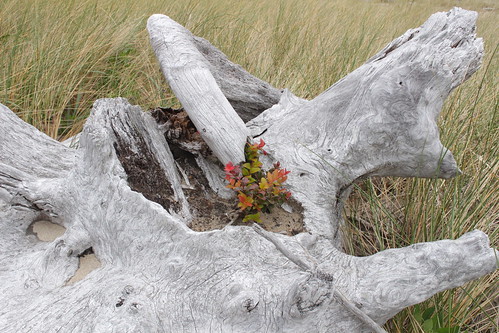Daweson shows how it's done










Jake Gibbs, a forester with more than 20 years of experience, has been chosen as the next president and CEO of Starker Forests, the venerable family timber company based in Corvallis, Ore.
Gibbs began work May 22 and will take over as president and CEO on July 15, when the company’s board of directors meets. Gibbs comes to Starker from another family business, Lone Rock Timber Management in Roseburg, Ore., which was involved in a controversial proposal to purchase the Elliott State Forest.
Gibbs began as a tree planter, gained silviculture and logging experience and in 2016 was listed as Lone Rock’s external affairs director.
In a message to Starker employees, Gibbs said he is “excited and humbled” to be selected to lead the company. “I’m not an OSU grad, but don’t hold that against me,” he said. Starker Forests is heavily involved in community affairs and is a major supporter of Oregon State University’s forestry program, including the annual Starker Lecture series.
Gibbs replaces Bond Starker, who announced his retirement pending the selection of a replacement. The company was founded by his grandfather, T.J. Starker, who taught forestry at OSU and purchased timberland in the area.
Oregon wheat farmers, like their counterparts in Washington and Idaho, are using additional fungicide treatments to stave off stripe rust this year.
Christina Hagerty, a plant pathologist with Oregon State University’s Columbia Basin Agricultural Research Center near Pendleton, said a heavier than normal snowfall and extended periods of cold and rain from fall to spring resulted in conditions ideal for diseases.
She said the season is shaping up to have higher than average stripe rust infections, and the weather conditions also were conducive to development of snow mold and wheat mosaic virus, which Oregon growers usually don’t see.
The situation is part of a conundrum faced by North Central and Eastern Oregon’s dryland wheat producers in particular. In Pendleton, 9.14 inches of rain has fallen since January — 3 inches more than normal, according to the National Weather Service.
Additional precipitation in a region that gets by on 8 to 20 inches of rain per year is always welcome, but can come with a cost.
“The conditions that lead to good, strong, healthy plants often overlap with conditions that lead to good, strong, healthy pathogens,” Hagerty said. A lack of moisture limits plant growth, but it also keeps pathogens in check, she said.
“I have heard folks with far more experience than me say that big rust years often have the highest yields,” she said.
Christopher Mundt, a plant pathology professor who supervised Hagerty’s Ph.D. work at OSU, said he sometimes jokes that stripe rust emergence is a good sign. “That means they’ve got enough water to have a good crop,” he said.
He said growers were able to see stripe rust developing last fall.
“Rust got established really early,” he said. “It’s a pathogen that has a very high reproductive rate, it goes through multiple generations of reproduction. Anytime it starts early, there’s more chance for buildup.”
Disease-resistant varieties developed by wheat breeders kept stripe rust at bay for years, but new strains have spread, Mundt said.
Snow mold is more of a problem in colder areas such as Eastern Washington, he said. It can form when snow falls on wet ground and keeps it at 32 degrees for extended periods. In Oregon it’s rare, and plants often can shake off and grow out of initial damage.
Dry, hot weather can shut down stripe rust, especially in wheat varieties bred to have high temperature, adult plant resistance. Otherwise, fungicide applications are effective, but costly, the researchers said.
“Growers are out there looking for it,” Mundt said. “They’ve picked up the lesson that you can’t let rust get away from them.”
“It’s very expensive,” Hagerty said. “These are decisions our producers don’t take lightly, and our research and extension personnel spend a lot of time thinking about and understanding that cost tradeoff.”
Reduced wheat prices “make those decisions that much more challenging,” she said.
Hagerty said producers who use fungicide properly, following label directions, shouldn’t have a problem.
“Our customers know they can count on high quality Oregon wheat to be on label,” she said. “As long as you’re on label, you’re good to go on that.”
RICHLAND, Wash. — Generic promotions for maraschino cherries will continue this year but the outlook beyond that is doubtful as fewer processors make maraschinos and don’t want to pay for common promotions.
Norm Gutzwiler, a Wenatchee grower and president of the National Cherry Growers & Industries Foundation, raised the subject at a Washington State Fruit Commission meeting in Richland on May 17.
There was talk of dissolving NCGIF in the fall and possibly replacing it with a new national cherry association patterned after the U.S. Apple Association. It would discuss issues of fresh and processed cherries and lobby the federal government when needed.
NCGIF was formed in 1948 to lobby against excessive processed cherry imports. It is funded by assessments on growers and donations from processors in Washington, Oregon, California and Michigan. It once had an 18-member board that included growers and all kinds of processors — brine (to make maraschinos), frozen, canned, glazed and juice. But in the last eight to 10 years only briners have been involved with growers and now the briners have dropped out, Gutzwiler said.
The board is now two growers each from Washington, Oregon, California and Michigan, he said.
Seneca Foods Corp. of Marion, N.Y., bought out Diana Fruit of Santa Clara, Calif., and Gray & Co. of Portland with its operations in Oregon and Michigan. A California company is buying out the briner portion of Oregon Cherry Growers in Salem, the largest briner in the Pacific Northwest.
“Some of the new processors haven’t been in the business before and haven’t been interested in joining any industry group. They don’t want to pay the promotions and that makes the future of NCGIF uncertain,” said Dana Branson, a Hood River, Ore., grower and NCGIF administrator until a year ago.
The foundation has averaged $300,000 annually for generic maraschino cherry promotions, depending on crop size, which is a small budget, she said.
Gutzwiler said that level of promotions will continue this year from 2016 assessments and donations but that NCGIF likely will dissolve this fall because growers don’t want to shoulder the whole cost. Assessments would end, he said. The budget once was a 50-50 split between growers and processors, he said.
SALEM — A proposed bill imposing new financial liability on biotech patent holders in Oregon would effectively banish genetically engineered crops from the state, opponents claim.
Under House Bill 2739, biotech patent holders would be liable for triple the economic damages caused by the unwanted presence of genetically modified organisms, or GMOs.
The bill is now before the House Rules Committee, which is considering an amendment clarifying when landowners can file lawsuits over GMOs on their property and the defenses available to patent holders, among other provisions.
The amendment would also ensure that patent holders cannot transfer liability to farmers who cultivate GMOs, though they could transfer liability to seed companies.
“It’s putting the onus on the producers and people who sell these crops rather that grow them,” said Amy van Saun, an attorney with the Center for Food Safety, a non-profit that supports HB 2739.
By making patent holders liable for unwanted GMO presence — either through cross-pollination or seed dispersal — the bill reduces potential conflicts among farmers, said Elise Higley, executive director of the Our Family Farms Coalition, which supports HB 2739.
“We don’t believe the GE farmer should be held responsible when they follow all the rules,” Higley said during a May 23 legislative hearing.
Biotech crops have “tracer genes” to identify patent holders, eliminating confusion about the source of an unwanted GMO, she said. “There’s no arguing about it. It’s just black and white science.”
Critics of HB 2739 believe the underlying goal of the proposal is to stop production of GMOs in Oregon.
For developers of genetically engineered crops, the risk of lawsuits would likely outweigh the benefits of licensing biotech traits to growers in the state, opponents say.
“If this bill passes, those seed companies may stop selling to Oregon completely,” said Shelly Boshart-Davis, whose family plants genetically engineered alfalfa between rows of hazelnut trees.
Likewise, Oregon State University breeders would be reluctant to use new gene editing techniques due to the financial risks of licensing the resulting crop varieties, said Dan Arp, dean of OSU’s College of Agricultural Sciences.
“As the patent holder, we would be liable for the judgment,” Arp said.
The bill was subject to sharp questioning by several Republican lawmakers, but the committee’s chair, Jennifer Williamson, D-Portland, ended the hearing without any remarks about HB 2739’s future, such as a possible work session.
In April, the House Judiciary Committee moved the bill without recommendation to the House Rules Committee, where it’s not subject to the same legislative deadlines as in other committees.
LAS CRUCES, N.M. (AP) — The Organ Mountains-Desert Peaks National Monument is celebrating its third birthday. But the flickering of candles on the cake may dim under the glare of federal scrutiny.
The 496,330-acre monument, created by President Barack Obama on May 21, 2014, has become a point of pride for some and a bone of contention for others. On April 26, President Donald Trump signed an executive order calling for a review of the OMDP, along with 26 others including the Rio Grande del Norte National Monument in northern New Mexico.
Earlier in April, the New Mexico Cattle Growers’ Association urged President Donald Trump to eliminate certain large-scale national monuments, including the OMDP. NMCGA officials said they are first seeking the elimination of the OMDP monument, but, if that doesn’t happen, they’d back a reduction in its size.
NMCGA President Pat Boone, from Elida, points to testimony to the state Legislature given by an NMCGA member who owns and operates a cattle ranch within the boundaries of OMDP, 77 percent of which is covered by the monument designation but all of which is impacted due to the layout of private and state trust lands within their grazing allotment.
That rancher, like others, is concerned that language in the monument designation remains vague as to what is to be protected, Boone said. Protecting wildlife and plant populations, which vary over time, creates uncertainty and will lead to burdensome government regulations, forcing ranchers out of business, he said.
“Perhaps the largest concern or fear from the ranching community is that, even after three years, there remains so much uncertainty,” Boone wrote in an email to the Sun-News. “No one knows what the impacts, financial or otherwise, are going to be. The designation puts an additional layer of unknown bureaucracy on ranchers.
“We question what this will do financially. Will lenders who hold mortgages on ranches, livestock and/or equipment continue to lend? Will cattle numbers be cut? Will visitors and environmentalists try to drive livestock use from the lands,” Boone continued. “If these questions had answers, attitudes might be different.”
RETURN TO ORIGINAL PLAN
U.S. Rep. Steve Pearce said he has heard those concerns and believes the monument area around the Organ Mountains should be maintained at the roughly 60,000-acre footprint originally proposed.
“The law is very specific,” Pearce said. “The footprint is supposed to be as small as possible to protect individual items . you can’t just say we want to protect open space.”
Ranchers are also concerned about border safety and the possible inability of law enforcement to easily enter the monument, Pearce said. They point to concerns by landowners near the Organ Pipe Cactus National Monument in southern Arizona where entire blocks of acreage are inaccessible and closed to the public for safety reasons. Those landowners also have to deal with the refuse left by immigrants making the dangerous border crossing, he said.
When visiting landowners near the OMDP recently, Pearce said they rarely see anyone using the monument for recreation and question the need for the designation.
Three sites in the Organ Mountains — Dripping Springs Natural Area, Aguirre Spring Campground and the Soledad Canyon Day Use Area — have seen a marked increase in the number of visitors. Tracking visitor growth in other areas of the monument is difficult. Using the numbers at those three sites, economic experts calculate an $8.2 million to $33.8 million benefit to the area.
Pearce notes the monument’s designation comes with a cost as well. The first casualty of the designation was the moving of the Chile Challenge, an off-road and 4X4 event in the Robledo Mountains that drew $4 million a year to the region, Pearce said. That event now takes place in Sierra County.
“In the West, the custom and culture is ranching,” Pearce said. “It’s something that the law was not supposed to change, our custom and culture, and it is.”
It’s legally unclear whether Trump or any future president could single-handedly eliminate or shrink a national monument. A more-certain path to eliminate or reduce the size of a monument would be an act of Congress signed into law by the president.
Through July 10, the Department of the Interior is asking the public to comment on 22 monuments — including OMDP — designated or expanded under the Antiquities Act since 1996.
Greg Carrasco has ranched on roughly 14 sections of land on the western edge of the monument, the northern half of which lies within the monument, for 14 years. He believes that additional federal oversight and regulations are burdensome and the current lack of a management plan, which BLM is developing, will favor preservation of wildlife and plants at the expense of proper land management techniques which ranchers have long practiced.
He also fears access to improvements such as fences, wells and water tanks will be limited. Each instance of a downed fence or out-of-service water tank could require individual permits, he said. And, he notes, those water systems installed and maintained by ranchers are often the only source of water for wildlife in the area.
Regulation “has tended to result in the loss of grazing capacity for ranchers,” he said. “We’ve already had a couple of preliminary meetings with the Bureau of Land Management about additional restrictions to access improvements, maintain improvements. I’m somewhat concerned about what long-term brush control and other options may be limited by these regulations.”
Bill Childress, manager of the BLM Las Cruces District, said the process of developing a management plan for the monument is under way. Meetings were held with stakeholders and user groups in early 2017. Now, the BLM is working on a management situation analysis. Once that is complete, likely in October or November, the formal planning process will begin. A finalized management plan should be complete in 2020, Childress said.
Like many, Carrasco sees the benefit of having a national monument for the Organ Mountains, but said it should be limited to that area. That would also allow the BLM to make more improvements for public access along the Organs and create a better destination for outdoor recreation, he said.
“I think the Organs are a majestic backdrop to Dona Ana County and Las Cruces in particular,” Carrasco said. “Concentrate the resources we have and make them a great destination for tourists and all kinds of outdoor activities. I very much would like the monument reduced back in size to the roughly 58,000-acre area on the foothills of the Organs.”
“The ranching community has been buried in regulation and limitations over the past 25 years,” the NMCGA’s Boone said. “More often than not, we can see what the outcomes down the road will be but we have no standing to protest until a rancher is put out of business. I characterize this as the ‘dead body theory.’ No one will do anything until there is a ‘dead body.’ But there is no way to revive a dead body — or a ranch that has been driven to the ground.”
The Westland Irrigation District is abandoning years of work to secure additional water from the Columbia River in order to defend a lawsuit filed by patrons alleging “massive misappropriation” of senior water rights.
Farmers reacted with surprise and disappointment Monday during a special district board meeting, where members voted unanimously to back out of the Central Project — one of three proposals to pump mitigated Columbia River irrigation water in Umatilla and Morrow counties.
Unlike the neighboring Stanfield and Hermiston irrigation districts, Westland does not have the ability to switch over to Columbia River water when flows from the Umatilla River drop below a certain point in the summer. That means the district depends entirely on Mother Nature, as well as stored water in McKay Reservoir.
Riding the momentum of a regional effort led by the Northeast Oregon Water Association, or NOWA, Westland had sought to tap into the Columbia and guarantee a full irrigation season for producers. It even appeared the district was on the verge of a deal, holding weekly meetings with patrons to iron out legal and logistical details moving forward.
Instead, the Central Project fell apart over a lawsuit accusing Westland of systematically cheating small farmers out of their senior water rights for the benefit of a few larger farms with junior rights. The case, which was originally tossed from federal court, will proceed in Umatilla County Circuit Court after Judge Michael Gillespie denied the district’s motion to dismiss last week.
A trial will likely be scheduled in the next six to nine months, according to Westland board chairman Bob Levy. And though Levy said he is confident the district will prevail, he felt it was unfair for patrons to invest in the project up front only to have it potentially stalled by legal challenges.
“The district is looking to defend this litigation for months to come,” Levy explained to a room full of patrons who packed the Umatilla County Fire District 1 station on Westland Road. “If the plaintiffs are successful ... it disturbs the Central Project, and the Central Project will not work.”
The Central Project would have cost roughly $14.4 million, financed by patrons who agreed to buy the water. The state of Oregon also approved a funding package for water delivery projects during the 2015 Legislature, with $11 million earmarked for the basin.
However, according to the resolution passed Monday, the project as it was conceived depended on Westland’s “longstanding water delivery and distribution practices” that are now being challenged in court. Plaintiffs in the case argue the district is in violation of Oregon’s “first in time, first in right” water appropriation system.
Levy also said the lawsuit precluded Westland from applying for its share of state funding within the fixed time frame.
After reading over the resolution in silence, farmer Hoss Hodges, whose parents arrived in the district in 1968, could barely contain his frustration.
“This really interferes with our future,” Hodges said after slamming the table with his hand.
Others were more subdued while lamenting what they described as a lost opportunity.
“We damn sure needed that Columbia River water,” said Butch Shockman, who owns a small amount of land along Bridge Road in Hermiston.
The value of agricultural land in the Columbia Basin increases exponentially with irrigation. Without water, dryland crops such as wheat may yield around $100 per acre. Add one acre-foot of water and that value grows to $500 per acre; add three acre-feet, and the value rockets to $5,000 per acre.
Patty Horn, whose family has owned Butter Creek Ranch in the district since the 1960s, said she is worried that without sufficient water in the future, her son will eventually inherit a sandlot.
“If I lose my water, my land become worthless,” Horn said. “It took 30 years for us to get a shot at Columbia water. It’s a shame to see it go over a few suing the district.”
The lawsuit in question was filed by a group of patrons who, together, farm more than 1,650 acres with senior water rights that date back to 1903. They claim they are being cheated out of water to benefit three large farms with more than 5,000 acres, including Levy’s L&L Farms, Amstad Farms and Eagle Ranch, to the tune of $2.9 million in damages.
Dixie Echeverria, who owns ELH LLC and is one of the plaintiffs on the case, said in a written statement that they have “grave concerns” about the management of the district. In his ruling, Judge Gillespie encouraged both sides to consider mediation.
“This case is not this court’s first experience with a small district’s members suing the special district they are members of,” Gillespie wrote. “In very real terms, the district’s costs are borne directly by all of its members in one way or another.”
J.R. Cook, founder and director of NOWA, said it was painful to see the Central Project slip out of Westland’s grasp. But he added that does not mean the organization is ending its effort to secure bucket-for-bucket mitigated Columbia River water rights and pass them off to entities that can put them to use.
The overall vision includes three project areas, stretching from Boardman to east of Hermiston.
Cook said Westland had been positioned to be first in line to get a pipeline in the ground as one of those three projects. Instead, the NOWA board will explore other options.
“I think Westland is going to look back on this in five years and regret it,” Cook said.




| S | M | T | W | T | F | S |
|---|---|---|---|---|---|---|
|
|
|
2 |
|
4 |
5 |
6 |
|
7 |
8 |
9 |
|
|
12 |
13 |
|
14 |
15 |
16 |
|
18 |
19 |
|
|
21 |
22 |
23 |
|
|
26 |
27 |
|
28 |
29 |
30 |
|
|
|
|
Select the newsletter(s) to which you want to subscribe or unsubscribe.